Undergraduates in this semester’s Sedimentation and Stratigraphy course broke new ground in learning seismic sequence stratigraphy. Rather than using traditional 2D line exercises, the class utilized dGB’s OpendTect software package to interpret seismic data. This new educational approach is a product of collaboration between the TTU Earth Science Department, dGB OpendTect developers and geologists at Marathon Oil Company.**
In a two-hour lab session, students used OpendTect to view seismic data in 3D space, learning the software alongside basic geophysical survey concepts such as inlines and crosslines. Once comfortable with navigating the 3D seismic cube, students characterized reflector geometries using the HorizonCube tool. From there, it was a short mental hop to picking sequence boundaries and flooding surfaces in the North Sea dataset. The final product of the lab assignment was an interpretation using the Sequence Stratigraphic Interpretation System (SSIS).

OpendTect is an open-source seismic interpretation package, meaning that students could use the software in the classroom as well as on their own computers (if desired). Data for the exercise came from dGB’s Seismic Data Repository, a growing database of free seismic data to be used for education.

** To learn more about teaching sequence stratigraphy in 3D, please visit the OpendTect website, contact J. Wolak or attend our poster presentation at the 2013 AAPG Annual Conference and Exhibition: A new era in seismic sequence stratigraphy: Computational seismic stratigraphy in the undergraduate classroom

I’m glad to see students using state-of-the-art software and stratigraphic concepts at TTU. Please let us know how can we help you Dr. Wolak in the knowledge transfer to the students so they can hit the ground running and initiate a bright career in the oil industry.
This is really a good step to teach the young professionals at school/universities with the new technologies. This develops a thinking dimension to all students and then they can perform better when the join the industry.
Thanks Jeanette for this initiative.